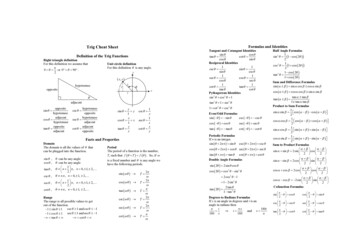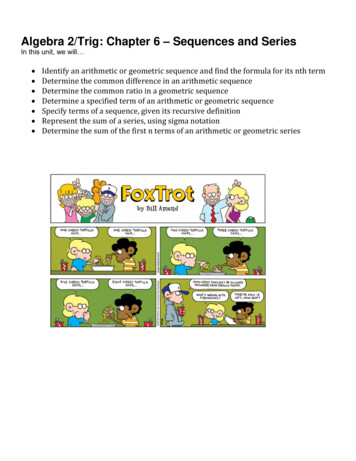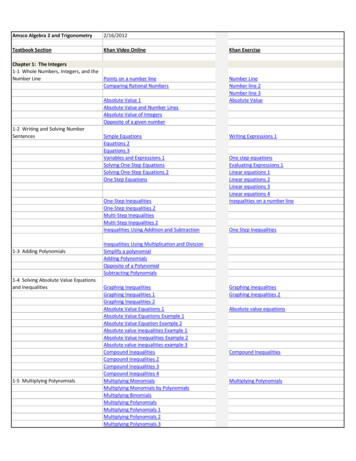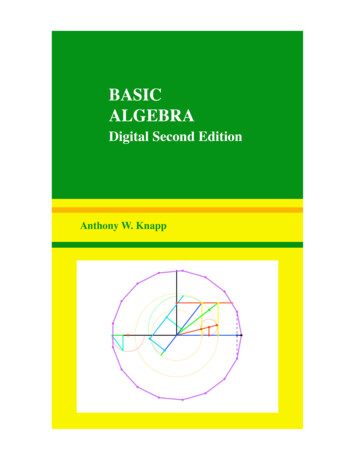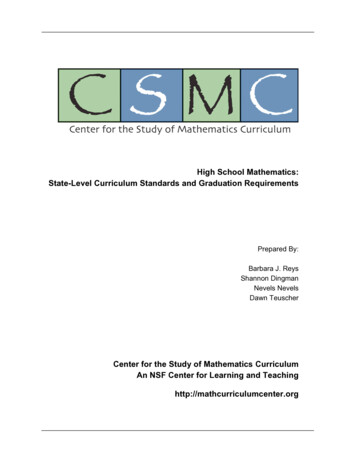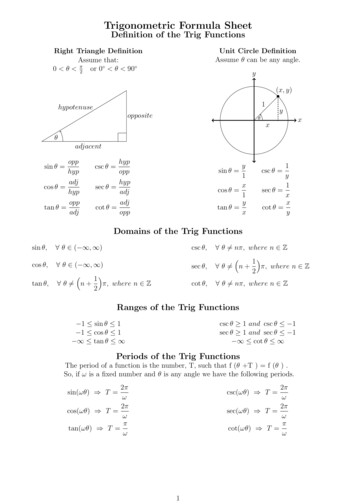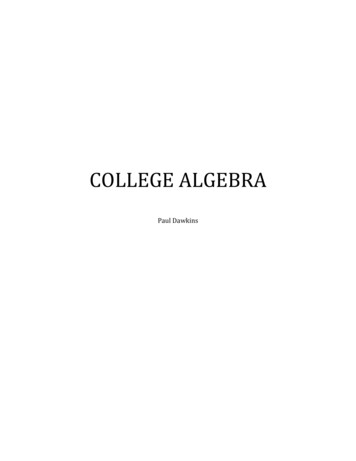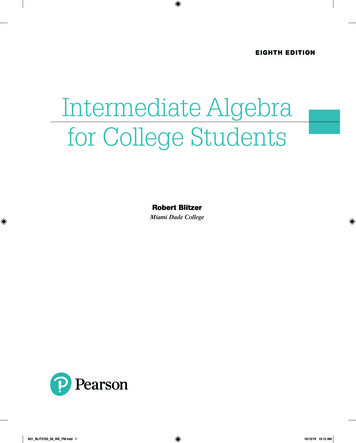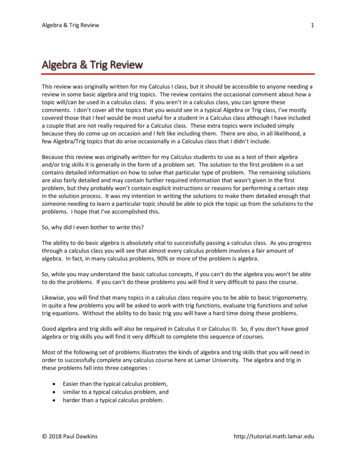
Transcription
Algebra & Trig Review1Algebra & Trig ReviewThis review was originally written for my Calculus I class, but it should be accessible to anyone needing areview in some basic algebra and trig topics. The review contains the occasional comment about how atopic will/can be used in a calculus class. If you aren’t in a calculus class, you can ignore thesecomments. I don’t cover all the topics that you would see in a typical Algebra or Trig class, I’ve mostlycovered those that I feel would be most useful for a student in a Calculus class although I have includeda couple that are not really required for a Calculus class. These extra topics were included simplybecause they do come up on occasion and I felt like including them. There are also, in all likelihood, afew Algebra/Trig topics that do arise occasionally in a Calculus class that I didn’t include.Because this review was originally written for my Calculus students to use as a test of their algebraand/or trig skills it is generally in the form of a problem set. The solution to the first problem in a setcontains detailed information on how to solve that particular type of problem. The remaining solutionsare also fairly detailed and may contain further required information that wasn’t given in the firstproblem, but they probably won’t contain explicit instructions or reasons for performing a certain stepin the solution process. It was my intention in writing the solutions to make them detailed enough thatsomeone needing to learn a particular topic should be able to pick the topic up from the solutions to theproblems. I hope that I’ve accomplished this.So, why did I even bother to write this?The ability to do basic algebra is absolutely vital to successfully passing a calculus class. As you progressthrough a calculus class you will see that almost every calculus problem involves a fair amount ofalgebra. In fact, in many calculus problems, 90% or more of the problem is algebra.So, while you may understand the basic calculus concepts, if you can’t do the algebra you won’t be ableto do the problems. If you can’t do these problems you will find it very difficult to pass the course.Likewise, you will find that many topics in a calculus class require you to be able to basic trigonometry.In quite a few problems you will be asked to work with trig functions, evaluate trig functions and solvetrig equations. Without the ability to do basic trig you will have a hard time doing these problems.Good algebra and trig skills will also be required in Calculus II or Calculus III. So, if you don’t have goodalgebra or trig skills you will find it very difficult to complete this sequence of courses.Most of the following set of problems illustrates the kinds of algebra and trig skills that you will need inorder to successfully complete any calculus course here at Lamar University. The algebra and trig inthese problems fall into three categories : Easier than the typical calculus problem,similar to a typical calculus problem, andharder than a typical calculus problem. 2018 Paul Dawkinshttp://tutorial.math.lamar.edu
Algebra & Trig Review2Which category each problem falls into will depend on the instructor you have. In my calculus courseyou will find that most of these problems falling into the first two categories.Depending on your instructor, the last few sections (Inverse Trig Functions through Solving LogarithmEquations) may be covered to one degree or another in your class. However, even if your instructordoes cover this material you will find it useful to have gone over these sections. In my course I spendthe first couple of days covering the basics of exponential and logarithm functions since I tend to usethem on a regular basis.This problem set is not designed to discourage you, but instead to make sure you have the backgroundthat is required in order to pass this course. If you have trouble with the material on this worksheet(especially the Exponents - Solving Trig Equations sections) you will find that you will also have a greatdeal of trouble passing a calculus course.Please be aware that this problem set is NOT designed to be a substitute for an algebra or trig course.As I have already mentioned I do not cover all the topics that are typically covered in an Algebra or Trigcourse. Most of the topics covered here are those that I feel are important topics that you MUST havein order to successfully complete a calculus course (in particular my Calculus course). You may find thatthere are other algebra or trig skills that are also required for you to be successful in this course that arenot covered in this review. You may also find that your instructor will not require all the skills that arelisted here on this review.Here is a brief listing and quick explanation of each topic covered in this review.AlgebraExponents – A brief review of the basic exponent properties.Absolute Value – A couple of quick problems to remind you of how absolute value works.Radicals – A review of radicals and some of their properties.Rationalizing – A review of a topic that doesn’t always get covered all that well in an algebraclass but is required occasionally in a Calculus class.Functions – Function notation and function evaluation.Multiplying Polynomials – A couple of polynomial multiplication problems illustrating commonmistakes in a Calculus class.Factoring – Some basic factoring.Simplifying Rational Expressions – The ability to simplify rational expressions can be vital insome Calculus problems.Graphing and Common Graphs – Here are some common functions and how to graph them.The functions include parabolas, circles, ellipses, and hyperbolas.Solving Equations, Part I – Solving single variable equations, including the quadratic formula.Solving Equations, Part II – Solving multiple variable equations.Solving Systems of Equations – Solving systems of equations and some interpretations of thesolution.Solving Inequalities – Solving polynomial and rational inequalities.Absolute Value Equations and Inequalities – Solving equations and inequalities that involveabsolute value. 2018 Paul Dawkinshttp://tutorial.math.lamar.edu
Algebra & Trig Review3TrigonometryTrig Function Evaluation – How to use the unit circle to find the value of trig functions at somebasic angles.Graphs of Trig Functions – The graphs of the trig functions and some nice properties that can beseen from the graphs.Trig Formulas – Some important trig formulas that you will find useful in a Calculus course.Solving Trig Equations – Techniques for solving equations involving trig functions.Inverse Trig Functions – The basics of inverse trig functions.Exponentials / LogarithmsBasic Exponential Functions – Exponential functions, evaluation of exponential functions andsome basic properties.Basic Logarithm Functions – Logarithm functions, evaluation of logarithms.Logarithm Properties – These are important enough to merit their own section.Simplifying Logarithms – The basics for simplifying logarithms.Solving Exponential Equations – Techniques for solving equations containing exponentialfunctions.Solving Logarithm Equations – Techniques for solving equations containing logarithm functions. 2018 Paul Dawkinshttp://tutorial.math.lamar.edu
Algebra & Trig Review4Algebra ReviewExponentsSimplify each of the following as much as possible.11. 2x 4 y 3 x 19 y 3 y 34SolutionAll of these problems make use of one or more of the following properties.1pnn mp mm nppn mp pp n m ( p n ) p nmmp 0 1, provided p 0 n p pnq ( pq ) p qn q nnn11pn npp np n nn p q qn pn q p This particular problem only uses the first property.4 3 192x y x13 34 y y 2x4 191 3 3 4 3y y 2x 15 3y y 512Remember that the y’s in the last two terms can’t be combined! You can only combine terms thatare products or quotients. Also, while this would be an acceptable and often preferable answer in acalculus class an algebra class would probably want you to get rid of the negative exponents as well.In this case your answer would be.4 3 192x y x13 y y 34 2x 15 3y y 512 21 53x yy 1215The 2 will stay in the numerator of the first term because it doesn’t have a negative exponent.3 12. x 5 x 2 x 2Solution3 13 2 16 20 5215210 10x 5 x 2 x 2 x x 10 x 10Not much to this solution other than just adding the exponents. 2018 Paul Dawkinshttp://tutorial.math.lamar.edu
Algebra & Trig Review 51xx 33.2 x5Solution 122 13xx 3x3x 3 x 5 x 3 1 133 x2 x5 2 x5222Note that you could also have done the following (probably is easier .). 13 13 13 4 1331 133xxxx xx x2 x5 2 x 4222In the second case I first canceled an x before doing any simplification.In both cases the 2 stays in the denominator. Had I wanted the 2 to come up to the numerator withthe x I would have used ( 2x ) in the denominator. So, watch parenthesis!5 2 54 6 2x x y 4. x y 3SolutionThere are a couple of ways to proceed with this problem. I’m going to first simplify the inside of theparenthesis a little. At the same time, I’m going to use the last property above to get rid of theminus sign on the whole thing. 3 2 54 6 2x x y x y x y 6 6 5 2x y 3Now bring the exponent in. Remember that every term (including the 2) needs to get the exponent. 3 2 54 6 33x y)x y)((2x x y 18 x y 6 3 5 183 6 35xy8 2 x (y ) Recall that ( x y ) x 3 y 3 so you can’t go any further with this.3 2018 Paul Dawkinshttp://tutorial.math.lamar.edu
Algebra & Trig Review1 74 92 1032 9 2x x x x x x5. x 1 6 0SolutionDon’t make this one harder than it has to be. Note that the whole thing is raised to the zero powerso there is only one property that needs to be used here.1 74 92 1032 9 2 xxxxxx x 1 2018 Paul Dawkins0 1 http://tutorial.math.lamar.edu
Algebra & Trig Review7Absolute Value1. Evaluate 5 and 123SolutionTo do these evaluations we need to remember the definition of absolute value. pp pWith this definition the evaluations are easy. 5 5 123 ( 123) 123if p 0if p 0because 5 0because -123 0Remember that absolute value takes any nonzero number and makes sure that it’s positive.2. Eliminate the absolute value bars from 3 8xSolutionThis one is a little different from the first example. We first need to address a very common mistakewith these.3 8x 3 8xAbsolute value doesn’t just change all minus signs to plus signs. Remember that absolute valuetakes a number and makes sure that it’s positive or zero. To convince yourself of this try plugging ina number, say x 1083 83 3 80 3 8 ( 10 ) 3 8 ( 10 ) 3 80 77There are two things wrong with this. First, is the fact that the two numbers aren’t even close tobeing the same so clearly it can’t be correct. Also note that if absolute value is supposed to makenonzero numbers positive how can it be that we got a -77 of out of it? Either one of these shouldshow you that this isn’t correct, but together they show real problems with doing this, so don’t do it!That doesn’t mean that we can’t eliminate the absolute value bars however. We just need to figureout what values of x will give positive numbers and what values of x will give negative numbers.Once we know this we can eliminate the absolute value bars. First notice the following (you doremember how to Solve Inequalities right?)So, if x 3 8x 0 3 8x 3 8x 0 3 8x 383x 8x 33then 3 8 x 0 and if x then 3 8 x 0 . With this information we can now88eliminate the absolute value bars. 2018 Paul Dawkinshttp://tutorial.math.lamar.edu
Algebra & Trig Review8 3 8 x3 8x ( 3 8 x ) 383if x 8 3 8 x3 8x 3 8 x 383if x 8if x Or,if x So, we can still eliminate the absolute value bars but we end up with two different formulas and theformula that we will use will depend upon what value of x that we’ve got.On occasion you will be asked to do this kind of thing in a calculus class so it’s important that youcan do this when the time comes around.3. List as many of the properties of absolute value as you can.SolutionHere are a couple of basic properties of absolute value.p 0p p These should make some sense. The first is simply restating the results of the definition of absolutevalue. In other words, absolute value makes sure the result is positive or zero (if p 0 ). Thesecond is also a result of the definition. Since taking absolute value results in a positive quantity orzero it won’t matter if there is a minus sign in there or not.We can use absolute value with products and quotients as followsa ab a bbabNotice that I didn’t include sums (or differences) here. That is because in generala b a bTo convince yourself of this consider the following example7 7 2 9 2 ( 9 ) 2 9 2 9 11Clearly the two aren’t equal. This does lead to something that is often called the triangle inequality.The triangle inequality isa b a bThe triangle inequality isn’t used all that often in a Calculus course, but it’s a nice property ofabsolute value so I thought I’d include it. 2018 Paul Dawkinshttp://tutorial.math.lamar.edu
Algebra & Trig Review9RadicalsEvaluate the following.1.3125SolutionIn order to evaluate radicals all that you need to remember is y x is equivalent to x y nnIn other words, when evaluating n x we are looking for the value, y, that we raise to the n to get x.So, for this problem we’ve got the following.3 125 5 because53 1252.664Solution3.6645 2432 because26 64Solution4.5 243 32100because( 3)5 243Solution 10025.4 100 102Remember that xx 16Solution4 16 n/aTechnically, the answer to this problem is a complex number, but in most calculus classes, includingmine, complex numbers are not dealt with. There is also the fact that it’s beyond the scope of thisreview to go into the details of getting a complex answer to this problem. 2018 Paul Dawkinshttp://tutorial.math.lamar.edu
Algebra & Trig Review10Convert each of the following to exponential form.6.7xSolutionTo convert radicals to exponential form you need to remember the following formula1np pnFor this problem we’ve got. 7x 7x21(7x)2There are a couple of things to note with this one. Remember p 2 p and notice theparenthesis. These are required since both the 7 and the x was under the radical so both must alsobe raised to the power. The biggest mistake made here is to convert this as7xhowever this is incorrect because12127x 7 xAgain, be careful with the parenthesis7.5x2Solution x5212 5x )( x25Note that I combined exponents here. You will always want to do this.8.34x 8Solution34 x 8 1( 4 x 8) 311You CANNOT simplify further to ( 4 x ) 3 ( 8 ) 3 so don’t do that!!!! Remember that(a b)n a n b n !!!!Simplify each of the following.9.316x 6 y13 Assume that x 0 and y 0 for this problem.SolutionThe property to use here isnxy n xnyA similar property for quotients is 2018 Paul Dawkinshttp://tutorial.math.lamar.edu
Algebra & Trig Review11nx ynnxyBoth of these properties require that at least one of the following is true x 0 and/or y 0 . Tosee why this is the case consider the following example4 16 ( 4 )( 4 ) 4 4 ( 2i )( 2i ) 4i 2 4If we try to use the property when both are negative numbers we get an incorrect answer. If youdon’t know or recall complex numbers you can ignore this example.The property will hold if one is negative and the other is positive, but you can’t have both negative.I’ll also need the following property for this problem.nxn xprovided n is oddIn the next example I’ll deal with n even.Now, on to the solution to this example. I’ll first rewrite the stuff under the radical a little then useboth of the properties that I’ve given here.316 x 6 y13 3 8 x3 x 3 y 3 y 3 y 3 y 3 2 y 3 8 3 x3 3 x3 3 y 3 3 y 3 3 y 3 3 y 3 3 2 y 2x x y y y y 3 2 y 2x2 y 4 3 2 ySo, all that I did was break up everything into terms that are perfect cubes and terms that weren’tperfect cubes. I then used the property that allowed me to break up a product under the radical.Once this was done I simplified each perfect cube and did a little combining.10.416x8 y15SolutionI did not include the restriction that x 0 and y 0 in this problem so we’re going to have to be alittle more careful here. To do this problem we will need the following property.nxn xprovided n is evenTo see why the absolute values are required consider 4 . When evaluating this we are reallyasking what number did we square to get four? The problem is there are in fact two answer to this :2 and -2! When evaluating square roots (or any even root for that matter) we want a predicableanswer. We don’t want to have to sit down each and every time and decide whether we want thepositive or negative number. Therefore, by putting the absolute value bars on the x we willguarantee that the answer is always positive and hence predictable.So, what do we do if we know that we want the negative number? Simple. We add a minus sign infront of the square root as follows 2018 Paul Dawkinshttp://tutorial.math.lamar.edu
Algebra & Trig Review12 4 ( 2) 2This gives the negative number that we wanted and doesn’t violate the rule that square root alwaysreturn the positive number!Okay, let’s finally do this problem. For the most part it works the same as the previous one did, wejust have to be careful with the absolute value bars.416 x8 y15 4 16 x 4 x 4 y 4 y 4 y 4 y 3 2 x x y y y 2 x y2 2x2 y3 43 44y3y3y3Note that I could drop the absolute value on the x 2 term because the power of 2 will give apositive answer for x 2 regardless of the sign of x. They do need to stay on the y term howeverbecause of the power. 2018 Paul Dawkinshttp://tutorial.math.lamar.edu
Algebra & Trig Review13RationalizingRationalize each of the following.1.3xyx ySolutionThis is the typical rationalization problem that you will see in an algebra class. In these kinds ofproblems you want to eliminate the square roots from the denominator. To do this we will use( a b )( a b ) a 2 b2 .So, to rationalize the denominator (in this case, as opposed to the next problem) we will multiplythe numerator and denominator by x y . Remember, that to rationalize we simply multiplynumerator and denominator by the term containing the roots with the sign between them changed.So, in this case, we hadx y and so we needed to change the “ ” to a “-”.Now, back to the problem. Here’s the multiplication.(3 xyx (y) () 3xy ( x y )x yy)x yx Note that the results will often be “messier” than the original expression. However, as you will seein your calculus class there are certain problems that can only be easily worked if the problem hasfirst been rationalized.Unfortunately, sometimes you have to make the problem more complicated in order to work with it.2.t 2 2t2 4SolutionIn this problem we’re going to rationalize the numerator. Do NOT get too locked into alwaysrationalizing the denominator. You will need to be able to rationalize the numerator occasionally ina calculus class. It works in pretty much the same way however.()((t 4) (t 2 22) t 2 2) (tt 2 2 t 2 42 4)(t 2 2)t 2( t 2 )( t 2 ) ((t 2) (t 2 21t 2 2))Notice that, in this case there was some simplification we could do after the rationalization. This willhappen occasionally. 2018 Paul Dawkinshttp://tutorial.math.lamar.edu
Algebra & Trig Review14 2018 Paul Dawkinshttp://tutorial.math.lamar.edu
Algebra & Trig Review15Functions x 2 6 x 11 and g 1. Given f ( x ) ( x)4 x 3 find each of the following.(a) f ( 2 )(b) g ( 2 )(c) f ( 3)(d) g (10 )(e) f ( t )(f) f ( t 3)(g) f ( x 3)(h) f ( 4 x 1)SolutionAll throughout a calculus sequence you will be asked to deal with functions so make sure that youare familiar and comfortable with the notation and can evaluate functions.First recall that the f ( x ) in a function is nothing more than a fancy way of writing the y in anequation so x 2 6 x 11f ( x) is equivalent to writingy x 2 6 x 11except the function notation form, while messier to write, is much more convenient for the types ofproblem you’ll be working in a Calculus class.In this problem we’re asked to evaluate some functions. So, in the first case f ( 2 ) is asking us todetermine the value of y x 2 6 x 11 when x 2 .The key to remembering how to evaluate functions is to remember that you whatever is in theparenthesis on the left is substituted in for all the x’s on the right side.So, here are the function evaluations.(a) f ( 2 ) ( 2 ) 6(2) 11 32(b) g ( 2)4(2) 35(c) f ( 3) ( 3) 6( 3) 11 382(d) g ( 10 )4(10) 3372(e) f ( t ) t 6t 11Remember that we substitute for the x’s WHATEVER is in the parenthesis on the left. Often thiswill be something other than a number. So, in this case we put t’s in for all the x’s on the left.This is the same as we did for (a) – (d) except we are now substituting in something other than anumber. Evaluation works the same regardless of whether we are substituting a number orsomething more complicated. 2018 Paul Dawkinshttp://tutorial.math.lamar.edu
Algebra & Trig Review16(f) f ( t 3) ( t 3) 6 ( t 3) 11 t 2 12t 382Often instead of evaluating functions at numbers or single letters we will have some fairlycomplex evaluations so make sure that you can do these kinds of evaluations.(g) f ( x 3) ( x 3) 6 ( x 3) 11 x 2 12 x 382The only difference between this one and the previous one is that I changed the t to an x. Otherthan that, there is absolutely no difference between the two!Do not let the fact that there are x’s in the parenthesis on the left get you worked up! Simplyreplace all the x’s in the formula on the right side with x 3 . This one works exactly the sameas(f).(h) f ( 4 x 1) ( 4 x 1) 6 ( 4 x 1) 11 16 x 2 32 x 182Do not get excited by problems like (e) – (h). This type of problem works the same as (a) – (d) wejust aren’t using numbers! Instead of substituting numbers you are substituting letters and/or otherfunctions. So, if you can do (a) – (d) you can do these more complex function evaluations as well!2. Given f ( x ) 10 find each of the following.(a) f ( 7 )(b) f ( 0 )(c) f ( 14 )SolutionThis is one of the simplest functions in the world to evaluate, but for some reason seems to cause noend of difficulty for students. Recall from the previous problem how function evaluation works. Wereplace every x on the right side with what ever is in the parenthesis on the left. However, in thiscase since there are no x’s on the right side (this is probably what causes the problems) we simplyget 10 out of each of the function evaluations. This kind of function is called a constant function.Just to be clear here are the function evaluations.f ( 7 ) 10 f ( 0 ) 10 f ( 14 ) 10 23. Given f ( x ) 3 x x 10 and g ( x ) 1 20 x find each of the following. f ( x) g (a)( f g )( x ) (b) (d)( f g )( 5)(e)( f g )( x )(c)( fg ) ( x)(f) ( g f)( x )SolutionThis problem makes sure you are familiar with notation commonly used with functions. Theappropriate formulas are included in the answer to each part. 2018 Paul Dawkinshttp://tutorial.math.lamar.edu
Algebra & Trig Review(a)17(f g )( x ) f ( x ) g ( x ) 3 x 2 x 10 (1 20 x ) 3 x 2 x 10 1 20 x 3 x 2 19 x 9(b)f ( x) f ( x) g ( x) g (c)3 x 2 x 101 20 x( fg )( x ) f ( x ) g ( x )( 3x 2 x 10 ) (1 20 x ) 60 x3 23 x 2 201x 10(d) For this part (and the next two) remember that the little circle, , in this problem signifies thatwe are doing composition NOT multiplication!The basic formula for composition is( f g )( x ) f ( g ( x ) )In other words, you plug the second function listed into the first function listed then evaluate asappropriate.In this case we’ve got a number instead of an x but it works in exactly the same way.( f g )( 5) f ( g ( 5) ) f ( 99 ) 29512(e) Compare the results of this problem to (c)! Composition is NOT the same as multiplication so becareful to not confuse the two!( f g )( x ) f ( g ( x ) ) f (1 20 x )2 3 (1 20 x ) (1 20 x ) 10 3 (1 40 x 400 x 2 ) 1 20 x 10 1200 x 2 100 x 12 2018 Paul Dawkinshttp://tutorial.math.lamar.edu
Algebra & Trig Review18(f) Compare the results of this to (e)! The order in which composition is written is important! Makesure you pay attention to the order.( g f )( x ) g ( f ( x ) ) g ( 3 x 2 x 10 ) 1 20 ( 3 x 2 x 10 ) 60 x 2 20 x 199 2018 Paul Dawkinshttp://tutorial.math.lamar.edu
Algebra & Trig Review19Multiplying PolynomialsMultiply each of the following.1. ( 7 x 4 )( 7 x 4 )SolutionMost people remember learning the FOIL method of multiplying polynomials from an Algebra class.I’m not very fond of the FOIL method for the simple reason that it only works when you aremultiplying two polynomials each of which has exactly two terms (i.e. you’re multiplying twobinomials). If you have more than two polynomials or either of them has more, or less than, twoterms in it the FOIL method fails.The FOIL method has its purpose, but you’ve got to remember that it doesn’t always work. Thecorrect way to think about multiplying polynomials is to remember the rule that every term in thesecond polynomial gets multiplied by every term in the first polynomial.So, in this case we’ve got.( 7 x 4 )( 7 x 4 ) 49 x 2 28 x 28 x 16 49 x 2 16Always remember to simplify the results if possible and combine like terms.This problem was to remind you of the formula( a b )( a b ) a 2 b22. ( 2 x 5 )2Solution2Remember that 3 ( 3)( 3) and so( 2 x 5)2 ( 2 x 5)( 2 x 5) 4 x 2 20 x 25This problem is to remind you that(a b)n a n bnso do not make that mistake!(a b)and( 2 x 5)2n a n bn 4 x 2 25There are actually a couple of formulas here.( a b ) a 2 2ab b22( a b ) a 2 2ab b22You can memorize these if you’d like, but if you don’t remember them you can always just FOIL outthe two polynomials and be done with it 2018 Paul Dawkinshttp://tutorial.math.lamar.edu
Algebra & Trig Review3. 2 ( x 3)202SolutionBe careful in dealing with the 2 out in front of everything. Remember that order of operations tellsus that we first need to square things out before multiplying the 2 through.2 ( x 3) 2 ( x 2 6 x 9 ) 2 x 2 12 x 182Do, do not do the following2 ( x 3) ( 2 x 6 ) 4 x 2 24 x 3622It is clear that if you multiply the 2 through before squaring the term out you will get very differentanswers!There is a simple rule to remember here. You can only distribute a number through a set ofparenthesis if there isn’t any exponent on the term in the parenthesis.() 4. 2x 3 x x 2 x SolutionWhile the second term is not a polynomial you do the multiplication in exactly same way. The onlything that you’ve got to do is first convert everything to exponents then multiply.( 2 x3 x ) x 2x 12 32xx () x 2 x 1 73 4x2 2 x 2 x 2 2(5. ( 3 x 2 ) x 2 9 x 12)SolutionRemember that the FOIL method will not work on this problem. Just multiply every term in thesecond polynomial by every term in the first polynomial and you’ll be done.( 3x 2 ) ( x 2 9 x 12 )x 2 ( 3 x 2 ) 9 x ( 3 x 2 ) 12 ( 3 x 2 ) 3 x 3 25 x 2 18 x 24 2018 Paul Dawkinshttp://tutorial.math.lamar.edu
Algebra & Trig Review21FactoringFactor each of the following as much as possible.1. 100 x 2 81SolutionWe have a difference of squares and remember not to make the following mistake.100 x 2 81 (10 x 9 )2This just simply isn’t correct. To convince yourself of this go back to Problems 1 and 2 in theMultiplying Polynomials section. Here is the correct answer.100 x 2 81 (10 x 9 )(10 x 9 )2. 100 x 2 81SolutionThis is a sum of squares and a sum of squares can’t be factored, except in rare cases, so this is asfactored as it will get. As noted there are some rare cases in which a sum of squares can be factoredbut you will, in all likelihood never run into one of them.3. 3 x 2 13 x 10SolutionFactoring this kind of polynomial is often called trial and error. It will factor as( ax b )( cx d )where ac 3 and bd 10 . So, you find all factors of 3 and all factors of -10 and try them indifferent combinations until you get one that works. Once you do enough of these you’ll get to thepoint that you can usually get them correct on the first or second guess. The only way to get goodat these is to just do lots of problems.Here’s the answer for this one.3 x 2 13 x 10 ( 3x 2 )( x 5)4. 25 x 2 10 x 1SolutionThere’s not a lot to this problem.25 x 2 10 x 1 ( 5 x 1)( 5 x 1) ( 5 x 1)2When you run across something that turns out to be a perfect square it’s usually best write it assuch. 2018 Paul Dawkinshttp://tutorial.math.lamar.edu
Algebra & Trig Review225. 4 x 5 8 x 4 32 x 3SolutionIn this case don’t forget to always factor out any common factors first before going any further.4 x 5 8 x 4 32 x 3 4 x 3 ( x 2 2 x 8 ) 4 x3 ( x 4 )( x 2 )6. 125 x 3 8SolutionRemember the basic formulas for factoring a sum or difference of cubes.a 3 b3 ( a b ) ( a 2 ab b 2 )a 3 b3 ( a b ) ( a 2 ab b 2 )In this case we’ve got125 x 3 8 2018 Paul Dawkins( 5 x 2 ) ( 25 x 2 10 x 4 )http://tutorial.math.lamar.edu
Algebra & Trig Review23Simplifying Rational ExpressionsSimplify each of the following rational expressions.1.2x2 8x2 4 x 4SolutionThere isn’t a lot to these problems. Just factor the numerator and denominator as much as possiblethen cancel all like terms. Recall that you can only cancel terms that multiply the whole numeratorand whole denominator. In other words, you can’t just cancel the x 2 and you can’t cancel a 4 fromthe 8 in the numerator and the 4 in the denominator. Things just don’t work this way.If you need convincing of this consider the following
few Algebra/Trig topics that do arise occasionally in a Calculus class that I didn’t include. Because this review was originally written for my Calculus students to use as a test of their algebra and/or trig skills it is generally in the form of a
